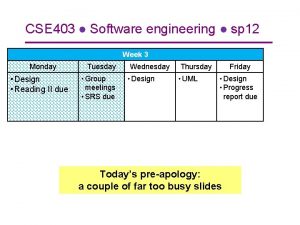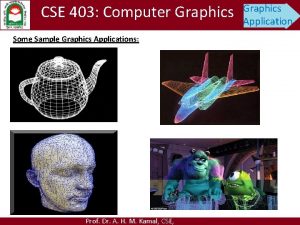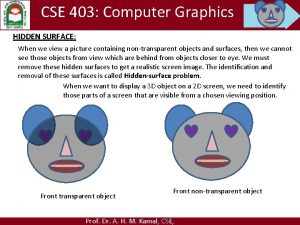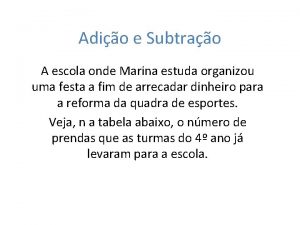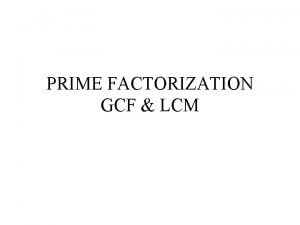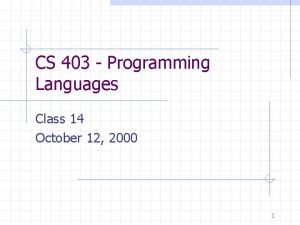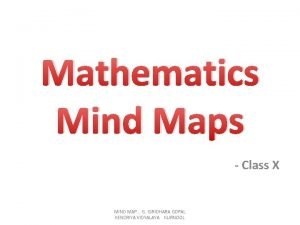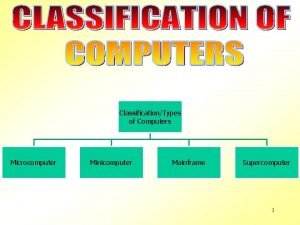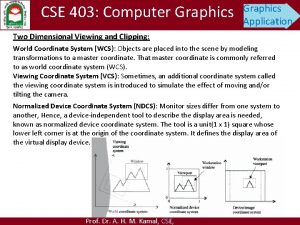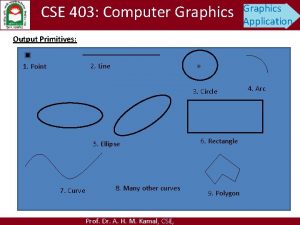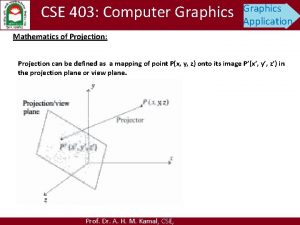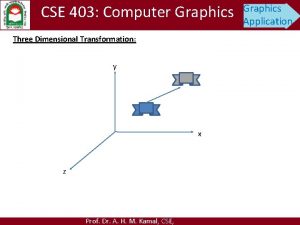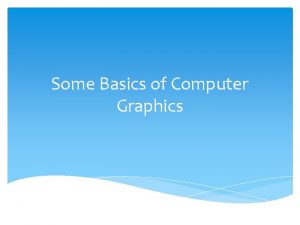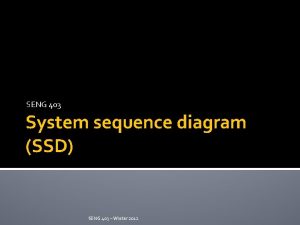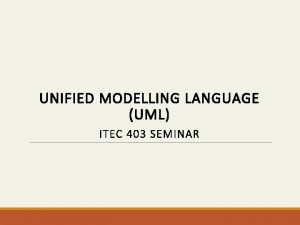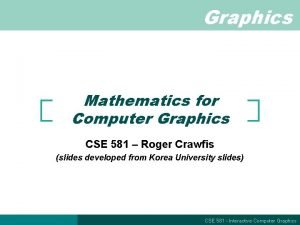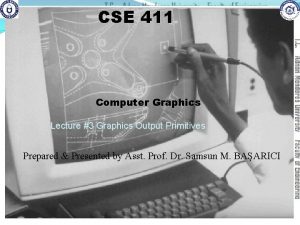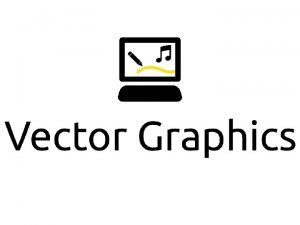CSE 403 Computer Graphics Some Sample Graphics Applications



























- Slides: 27

CSE 403: Computer Graphics Some Sample Graphics Applications: Prof. Dr. A. H. M. Kamal, CSE, Graphics Application

CSE 403: Computer Graphics Reference Books: 1. Computer Graphics - Shaume’s Outline -2 nd Edition 2. Introduction to Computer Graphics - Foley Evaluation System: Attendance Mid Term II Project work 10 10 Final 60 Total 100 Prof. Dr. A. H. M. Kamal, CSE, Graphics Application

Computer Graphics Applications: User Interface: Prof. Dr. A. H. M. Kamal, CSE, Tour to Graphics

Computer Graphics Applications: Interactive Ploting in Business, Science and Technology: Prof. Dr. A. H. M. Kamal, CSE, Tour to Graphics

Computer Graphics Tour to Graphics Computer Graphics Applications: Cartography: To produce accurate and schematic representation of geographical objects and natural other phenomena from measurement data. Example: Geographical map, relief map, etc. Prof. Dr. A. H. M. Kamal, CSE,

Computer Graphics Applications: Medicine: Used in diagnostic medicine and surgery planning. Prof. Dr. A. H. M. Kamal, CSE, Tour to Graphics

Computer Graphics Applications: Computer aided drafting and design: To design components and system of mechanical, electrical. Prof. Dr. A. H. M. Kamal, CSE, Tour to Graphics

Computer Graphics Applications: Multimedia System: Prof. Dr. A. H. M. Kamal, CSE, Tour to Graphics

Computer Graphics Applications: Simulation and animation for scientific visualization and animation: Prof. Dr. A. H. M. Kamal, CSE, Tour to Graphics

CSE 403: Computer Graphics Tour to Graphics Difference between Computer Graphics and Image Processing: Computer Graphics Image processing 1 refers to processing of creating a new image from Geometry , Lighting parameters , Materials and Textures using a Computer or any other digital media. is the process of manipulating an image acquired through some device. The image too often will be acquired from photograph, scanner, medical equipments. 2 synthesize pictures from mathematical or geometrical models. analyze pictures to derive descriptions of objects appeared in the pictures. Prof. Dr. A. H. M. Kamal, CSE,

CSE 403: Computer Graphics Tour to Graphics Basic Terminologies: Resolution Aspect Ratio Pixel Color Maximum number of points that can be displayed in the output. It is often represented by wxh, where w and h are the width and height of a display device. Gives the ratio of vertical points to horizontal points of a screen. Each screen point is referred to as a pixel, called picture element. Each pixel is represented by a color. The color can be of black-and-white, gray and RGB model. • Black-and-while color is represented by 0 and 1 (black and white). Hence, it is a 2 -bit color. • Gray pixel contains a value within 0 to 255. It is an 8 -bit color. Hence, a Black and White pixel can hold a value of 0 and 255 also. • RGB model presents a pixel value by mixing red (R) green (G) and blue (B) light with different intensities. Each of R, G and B color varies from 0 to 255. Thus RGB presents 256*256 different colors. It is a 24 -bit color. • An RGB color system with 24 bits of storage per pixel is generally referred to as a full-color or true-color system Prof. Dr. A. H. M. Kamal, CSE, JKKNIU

CSE 403: Computer Graphics RGB Color Model: Prof. Dr. A. H. M. Kamal, CSE, JKKNIU Tour to Graphics

CSE 403: Computer Graphics CMY Color Model: Prof. Dr. A. H. M. Kamal, CSE, JKKNIU Tour to Graphics

CSE 403: Computer Graphics Direct coding: Prof. Dr. A. H. M. Kamal, CSE, JKKNIU Tour to Graphics

CSE 403: Computer Graphics Indexed Color: Tour to Graphics The palette itself stores a limited number of distinct colors; 4, 16 or 256 are the most common cases. Here is a typical indexed 256 color image and its own palette (shown as a rectangle of swatches) A 2 -bit indexed color image. The color of each pixel is represented by a number; each number (the index) corresponds to a color in the color table (the palette). Prof. Dr. A. H. M. Kamal, CSE, JKKNIU

CSE 403: Computer Graphics Tour to Graphics Lookup Table for Color Grading: A color lookup table, CLUT is a way to transform a range of input colors into another range of colors. For example, it could be a software function incorporated into an image processing application. The device takes the colors stored in each pixel of video memory, and convert them into physical colors that are visible on a computer monitor or display device. 8 -bit pixel value Prof. Dr. A. H. M. Kamal, CSE, JKKNIU

CSE 403: Computer Graphics Tour to Graphics Display Devices: Three types 1. Emissive Displays 2. Non-emissive Displays 3. Hard Display 1. Emissive Displays: • Cathode Ray Tube (CRT): • Plasma Panels: is controlled by filling the region between two glass plates with mixture of gasses. • Thin Film Electroluminescent Display: is controlled by filling the region between two glass plates with a phosphor. • Light Emitting Diode (LED): A mixture of diode forms the pixels. 2. Non-Emissive Displays: • Liquid Crystal Display: Produces a picture by passing polarized light from the surroundings through a liquid crystal material. ay 3. Hard Displays: • Printer: Prof. Dr. A. H. M. Kamal, CSE, JKKNIU

CSE 403: Computer Graphics Tour to Graphics Refresh Buffer or Frame Buffer: Pictured definition is stored in a memory area called the frame buffer or refresh buffer. This memory area holds the set of intensity values for all the screen points. Stored intensity values are then retrieved from the refresh buffer and painted on the screen one row (scan line) at a time. On a Black and White system with one bit per pixel, the frame buffer is commonly called a bitmap. For system with multiple bits per pixel, the frame buffer is often referred to as a pixmap. Rendering: The process of generating a pixel image from a three dimensional virtual scene is called rendering. Prof. Dr. A. H. M. Kamal, CSE, JKKNIU

CSE 403: Computer Graphics Display Method: Two types • Raster Scan • Random Scan Prof. Dr. A. H. M. Kamal, CSE, JKKNIU Tour to Graphics

CSE 403: Computer Graphics Tour to Graphics Raster Scan: The complete image on a raster display is formed from the raster, which is a set of horizontal scan lines, each a row of individual pixels. The raster is thus stored as a matrix of pixels representing the entire screen area. Video controller scanned out sequentially one scan line at a time from top to bottom. And then back to the top. Prof. Dr. A. H. M. Kamal, CSE, JKKNIU

CSE 403: Computer Graphics Tour to Graphics Raster Scan: The complete image on a raster display is formed from the raster, which is a set of horizontal scan lines, each a row of individual pixels. The raster is thus stored as a matrix of pixels representing the entire screen area. Video controller scanned out sequentially one scan line at a time from top to bottom. And then back to the top. Prof. Dr. A. H. M. Kamal, CSE, JKKNIU

CSE 403: Computer Graphics Tour to Graphics Raster Scan: The complete image on a raster display is formed from the raster, which is a set of horizontal scan lines, each a row of individual pixels. The raster is thus stored as a matrix of pixels representing the entire screen area. Video controller scanned out sequentially one scan line at a time from top to bottom. And then back to the top. Prof. Dr. A. H. M. Kamal, CSE, JKKNIU

CSE 403: Computer Graphics Tour to Graphics Raster Scan: The complete image on a raster display is formed from the raster, which is a set of horizontal scan lines, each a row of individual pixels. The raster is thus stored as a matrix of pixels representing the entire screen area. Video controller scanned out sequentially one scan line at a time from top to bottom. And then back to the top. Interlaced Refresh Procedure: Each frame is displaced in two passed. • First pass displays even scan lines. • Second pass displays odd scan lines. Prof. Dr. A. H. M. Kamal, CSE, JKKNIU

CSE 403: Computer Graphics Tour to Graphics Raster Scan: The complete image on a raster display is formed from the raster, which is a set of horizontal scan lines, each a row of individual pixels. The raster is thus stored as a matrix of pixels representing the entire screen area. Video controller scanned out sequentially one scan line at a time from top to bottom. And then back to the top. Prof. Dr. A. H. M. Kamal, CSE, JKKNIU

CSE 403: Computer Graphics Tour to Graphics Random Scan: A CRT has a electron beam directed only to the parts of the screen where a picture is to be drawn. Prof. Dr. A. H. M. Kamal, CSE, JKKNIU

CSE 403: Computer Graphics Tour to Graphics Random Scan: A CRT has a electron beam directed only to the parts of the screen where a picture is to be drawn. Prof. Dr. A. H. M. Kamal, CSE, JKKNIU

CSE 403: Computer Graphics Display Processor (DP): Prof. Dr. A. H. M. Kamal, CSE, JKKNIU Tour to Graphics
 Cse 403
Cse 403 Cse 403
Cse 403 Cse 403
Cse 403 Po 403
Po 403 Medium voltage
Medium voltage Envirobond 403
Envirobond 403 403
403 Quantas prendas faltam para a turma 401 empatar com a 402
Quantas prendas faltam para a turma 401 empatar com a 402 225 factor tree
225 factor tree Envoy 403b
Envoy 403b Navair 00-25-403
Navair 00-25-403 Subprogram c++
Subprogram c++ Computer graphics
Computer graphics Computer graphics introduction ppt
Computer graphics introduction ppt Polynomial concept map class 10
Polynomial concept map class 10 Sometimes you win some sometimes you lose some
Sometimes you win some sometimes you lose some Sometimes you win some
Sometimes you win some Cake è countable or uncountable
Cake è countable or uncountable Contact and noncontact forces
Contact and noncontact forces Fire and ice diamante poem
Fire and ice diamante poem Some say the world will end in fire some say in ice
Some say the world will end in fire some say in ice Some trust in horses
Some trust in horses Uses of computer network in business application
Uses of computer network in business application A computer company receives 350 applications
A computer company receives 350 applications Uses of minicomputer
Uses of minicomputer Principles of network applications in computer networks
Principles of network applications in computer networks Objectives of computer applications
Objectives of computer applications Computer integrated manufacturing applications
Computer integrated manufacturing applications
